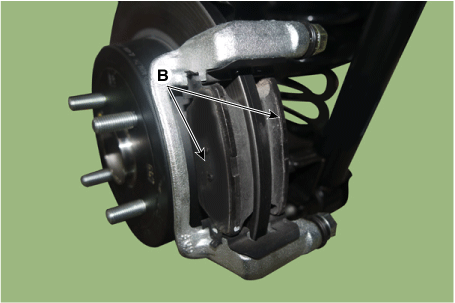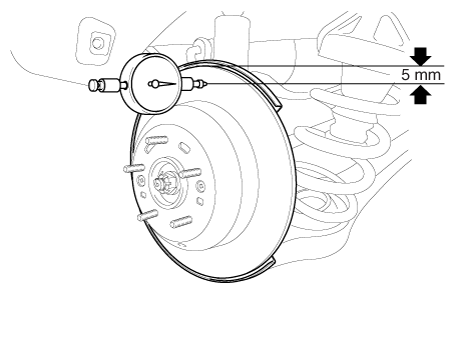Kia Rio: Brake System / Rear Disc Brake
Components and components location
| Components |

| 1. Cable cuide & Lever 2. Caliper body 3. Torque member |
4. Brake pad 5. Return spring |
Repair procedures
| Removal |
Disc
| 1. |
Remove the rear wheel & tire.
|
| 2. |
Release the parking brake lever and parking brake cable is loose. |
| 3. |
Remove the parking brake cable (A), after removing the clip (B).
|
| 4. |
Pull the spanner as a below arrow in order to loosen the cable and then remove the parking cable (A).
|
| 5. |
Remove the hose eyebolt (A).
|
| 6. |
Loosen the caliper mounting bolts and then remove the rear caliper assembly.
|
| 7. |
Loosen the rear disc screw (A) and then remove the rear disc.
|
Brake Pad
| 1. |
Remove the rear wheel & tire.
|
| 2. |
Loosen the caliper mounting bolts and then remove the rear caliper assembly.
|
| 3. |
Remove the pad return spring (A) and then separate the brake pad (B).
|
| Inspection |
Rear Brake Disc Thickness Check
| 1. |
Check the brake pads for wear and fade. |
| 2. |
Check the brake disc for damage and cracks. |
| 3. |
Remove all rust and contamination from the surface, and measure the disc thickness at 8 points, at least, at the same distance apart (5mm) from the brake disc outer circle.
|
| 4. |
If wear exceeds the limit, swab left and right discs and pad assemblies of the vehicle. |
Rear Brake Pad Check
| 1. |
Check the pad wear. Measure the pad thickness and replace it, if it is less than the specified value.
|
| 2. |
Check that grease is applied to sliding contact points and check the pad and backing metal for damage. |
Rear Brake Disc Runout Check
| 1. |
Place a dial gauge about 5mm (0.2 in.) from the outer circumference of the brake disc, and measure the runout of the disc.
|
| 2. |
If the runout of the brake disc exceeds the limit specification, replace the disc, and then measure the runout again. |
| 3. |
If the runout does not exceed the limit specification, install the brake disc after turning it 180° and then check the brake disc again for runout. |
| 4. |
If the runout cannot be corrected by changing the position of the brake disc, replace the brake disc. |
| Installation |
| 1. |
Install in the reverse order of removal. |
| 2. |
Use the SST (09581-11000) when installing the brake caliper assembly.
|
| 3. |
After installation, bleed the brake system. (Refer to Brake system - "Brake System") |
 Front Disc Brake
Front Disc Brake
Components and components location
Components
1. Caliper body
2. Caliper carrier
3. Brake pad assembly [IN]
4. Brake pad assembly [OUT]
5. Pad return ...
 Rear Drum Brake
Rear Drum Brake
Components and components location
Components
1. Shoe hold down pin
2. Shoe adjuster
3. Upper return spring
4. Adjusting lever
5. Shoe
6. Adjusting s ...
Other information:
Kia Rio 2017-2020 YB Service Manual: Fuel Filter (For Diesel engine only)
Repair procedures Replacement 1. Turn ignition switch OFF and disconnect the negative (-) battery terminal. 2. Remove the battery. (Refer to Engine Electrical System - "Battery") 3. Remove the ECM. (Refer to ...
Kia Rio 2017-2020 YB Owners Manual: Winter driving
Severe weather conditions in the winter result in greater wear and other problems. To minimize the problems of winter driving, you should follow these suggestions: Snowy or Icy conditions To drive your vehicle in deep snow, it may be necessary to use snow tires. If snow tires are needed, it ...














